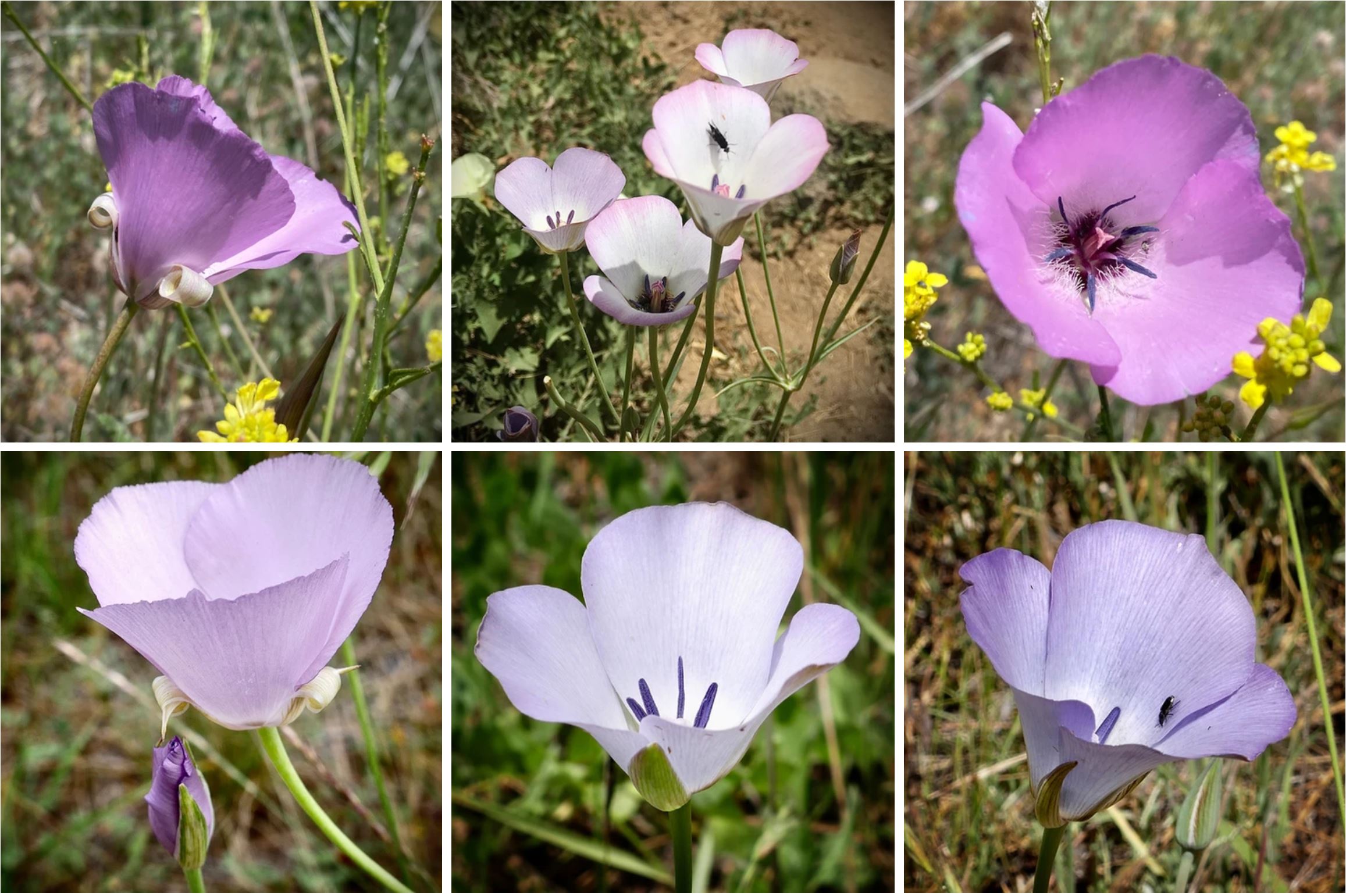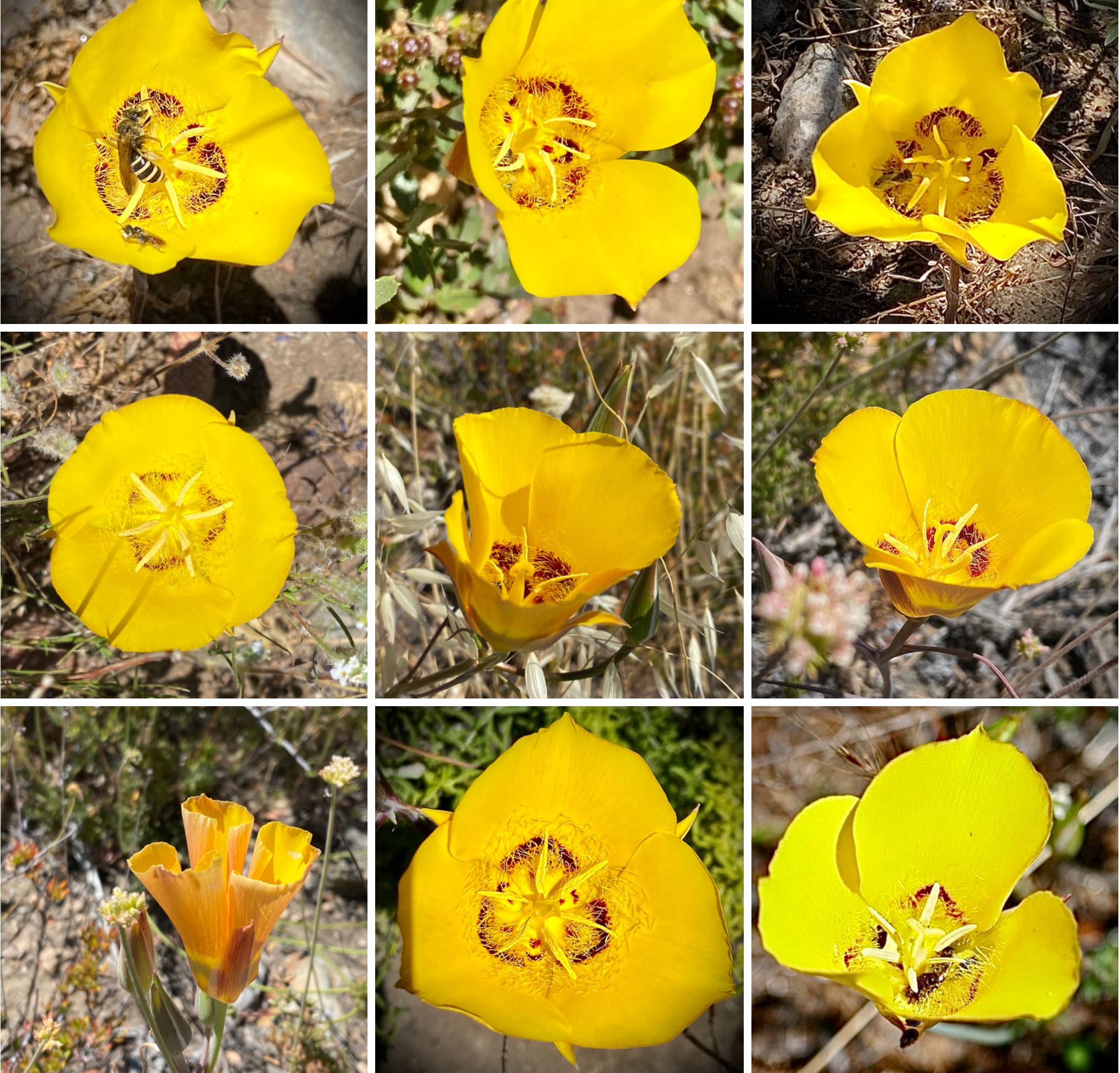I'm not exactly sure when I first became aware of Calochortus.
 |
| Calochortus weedii - July 2019 in the northern annex of Torrey Pines State Natural Reserve |
I seem to recall in the 1980s they were occasionally offered for sale under "rare and unusual" in bulb catalogues. For some reason, I associated them with the Pacific Northwest. I also knew that the common name Mariposa lily was referring to Calochortus. And that the state flower of Utah is the Sego lily, which I'd seen a few times while traveling in Utah and learned that it too was a Calochortus - C. nuttallii. However, I wasn't aware of them growing locally until the mid-1990s. I used to mountain bike ride after work in Peñasquitos Canyon. I crossed over to the north side of the creek and followed a rough and rutted road part way up Black Mountain. The road ended and there some trails with lots of cobblestones leading west to some single track trails, originally for horses. It was there one day in June I spotted a mass of tall almost leafless bright yellow tulip shaped flowers with intricate markings with dark splotches and hairs on the inside. I'd stop to marvel at them and get a closer look whenever they were in bloom. Doing some research, I learned that these too were mariposa lilies, but it would be several more years before I learned their full botanic names Calochortus weedii.
 |
| Photos of Calochortus weedii in Torrey Pines and the Laguna Mountains |
Calochortus are indeed lilies. There are about 70 known species, primarily in the western states and into Canada and as far south as Guatemala. But as with so many plants, California has the most endemic species. 28 in total.
Rather than me describing them here is what Wikipedia has to say:
Calochortus flowers have six tepals. Unlike most other Liliaceae, Calochortus tepals are in two series that differ in size and color. The outer three are generally narrower and more sepal-like, while the inner three are larger, usually with bright marks at the base. They may be described as petals. The flowers are borne on a stem that arises from a bulb, generally in the spring or early summer. Flowers can be white, yellow, pink, purple, bluish, or streaked. The insides of the petals are often very 'hairy'. These hairs, along with the nectaries, are often used in distinguishing species from each other.
While I've always thought the botanical name is kind of cool having both Cal- sort of California- and hortus - which makes me thing of horticulture - the name actually comes from Greek meaning "beautiful grass". Most do have slender grass-like leaves that make them difficult to locate when not in bloom and all have beautiful, if not sensational, flowers.
And regarding that second name weedii, it isn't that they are weedy but that they are named after Amos Weed. He was involved in gold mining in our local mountains around Julian and Banner in the late 1800s. The name for plant has been around since at least 1874, but I couldn't find out who decided to name them after him or why.
Fast forward, to around 2009. It was the year I started hiking in Torrey Pines State Natural Reserve. I'd cycled up and down the road inside the park maybe 1000s of times in the previous 20 years, but never had actually hiked there. Back then I was the assistant coordinator of the San Diego County Fair Flower and Garden show. I started hiking the trails after work to relax from all of the daily drama that went on at the Fair. The spring wildflowers in 2009 and 2010 were excellent and I started learning all of their names when I noticed the mariposa lilies blooming towards the end of the June. I immediately recognized them from the trails across the freeway in Peñasquitos and finally found out their botanical name.
Almost another decade would pass until the late spring of 2019. This was the year of the 'superbloom' in Southern California and the wildflowers and cool weather lingered well into the summer. In June of that year Scott and I went for a hike in the Laguna Lakes area. We stopped briefly at a pullout just north of the I-8 on highway 79 and there we found many Calochortus weedii in bloom right next to the road. We've returned there this year (2023) and only found a few blooms as the area has mostly been overtaken by non-native grasses. But it was later in the day in 2019 on the trail that I noticed a different mariposa lily. This one was more tulip-like without the hairs, lavender to pink in color and with a more elegant form. It is the Calochortus splendens and is in fact splendid to behold.
 |
| Calochortus splendens - Mt. Laguna and Green Valley in the Cuyamaca State Park |
Through Facebook friends and the California Native Plant Society Facebook page, I would learn there are many other varieties across California. Two that intrigued me are mostly in Northern California - the White Fairy Lantern (C. albus) and Pussy's ears (C. tolmiei).
I was unaware that C. albus grows in local areas. During the shutdown in May of 2020, we went for a hike in the Cleveland National Forest at Dead Horse Canyon only to find that the BLM had closed all of its trails. So we backtracked and instead hiked partway up nearby Lawson's Peak. Unfortunately, the trail is near a shooting range and the almost continuous sound of gunshots and semi-automatic weapons being fired made for a somewhat disturbing hike. But there next to the trail were some tiny Fairy Lanterns. I was so excited!
 |
| White Fairy Lanterns - May 2020 along Lawson Peak Trail |
The next year in April 2021, in one of our first post-COVID trips we did a bike tour in Sonoma County. After the tour we stopped in Point Reyes to hike and see the wildflowers. I knew that C. tolmiei grew in the park and we found them atop the bluffs overlooking the Pacific Ocean mixed in with other wildflowers. Do wildflowers get any better than this one?
 |
| Calochortus tolmiei - April 2020, Point Reyes National Seashore |
This year (2023) in April we joined a Lindblad Expeditions National Geographic cruise of the California Channel Islands. We did a hike on Santa Rosa Island to see the grove of Torrey Pines. Along the trail we found an occasional C. albus. The blooms were only a few here and there and wildly scattered along the trails.
 |
| Calochortus albus - April 2023, Santa Rosa Island Photo Credit: Jan Emming |
The next day we went ashore on the western side of Catalina Island. There we saw masses of Calochortus catalinae, the Santa Catalina mariposa lily. The heavy winter rains were the perfect condition for a heavy bloom.
 |
| Calochortus catalinae - April 2023, Shark Harbor Santa Catalina Island |
At the end of May, I headed to Torrey Pines State Reserve to see if I could find some C. splendens in bloom. In other years there are usually a few blooms near were the trail to Yucca Point splits off. However, this year there were 1000s of blooms in the area, the most Mariposa lilies I've ever witnessed in a small area.
 |
| Calochortus splendens - May 2023, Torrey Pines State Natural Reserve |
A couple of days later while touring a friends garden in El Cajon her husband led us on a trail through the chaparral next to their garden. Sprinkled throughout the chaparral were more Calochortus splendens. I'd love to find these growing in my backyard!
 |
| More Calochortus splendens - May 2023, Jamul |
Most recently on June 25th, we hiked to the top of Garnet Peak near Mt. Laguna. Along the trail was a mariposa lily that didn't look familiar. After doing some research (actually I posted the photos on the California Native Plant Society's webpage and asked if anyone knew the name) I found out they are Calochortus concolor, which is found mostly in the mountains of Southern California.
 |
| Calochortus concolor - June 2023, Garnet Peak Trail |
Some things amaze me about Calochortus. First is how incredibly beautiful they are. Next is how widespread they are across the western mountains and coast. But what is the most amazing is the variety of shapes and colors with hanging flowers, hairs, blotches, clear colors, etc. They can look very different within the same species yet somehow they are easily recognizable. And finally, more than 3 different species will sometimes grow in the same area, sometimes side by side, each with its own unique look.
I'm still on my search to see more. I hope to someday see the bright red-orange Calochortus kennedyi - desert mariposa lily with its solid color flowers. Also the on the list is Calochortus raichei - the yellow fairly lily that grows near, and is named after, California plantsman Roger Raiche. I met him several years ago on a garden tour. Plus, I'd like to someday see the other 50 species.
 |
| Point Reyes National Seashore |

Comments
Post a Comment